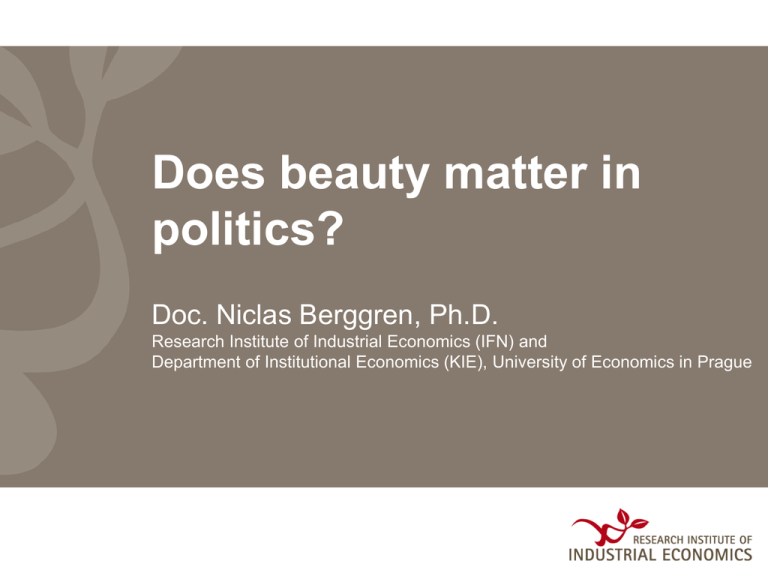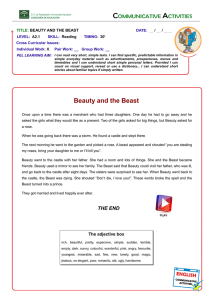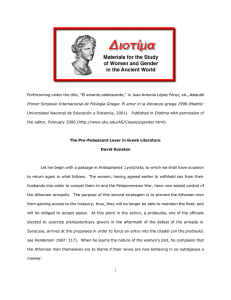Does beauty matter in politics?
Anuncio

Does beauty matter in politics? Doc. Niclas Berggren, Ph.D. Research Institute of Industrial Economics (IFN) and Department of Institutional Economics (KIE), University of Economics in Prague Good looking children and adults Judged more positively Treated better by others Better self-perception Exhibit more positive behaviors and traits Sources: Eagly et al. (1991); Langlois et al. (2000) Beauty premium in the US labor market Looks Wage adjusted for other determinants Women Men Above average 8% 4% Average 0 0 Below average -4% -13% Source: Hamermesh (2011). Beauty Pays. The beauty difference in wages is comparable to the effect of: • 1.5 years of schooling • 5 years of labor market experience • Working in a unionized workplace In experiments, attractive people are Believed to play more cooperatively Trusted more Given higher offers Paid more for same productivity (due to confidence and better social skills or due to preferences of “employers”) The psychology of beauty • Agreement on what constitutes human beauty, and especially human ugliness, is formed very early in life—probably during infancy. • Beautiful faces are associated with: – Symmetry – Youthfulness “Beauty is in the eye of the beholder” • Yes, but there is still much agreement: “The meta-analyses showed that, both within and across cultures, people agreed about who is and is not attractive.” (Langlois et al. 2000) Beauty in politics Judged more positively Treated better by others Exhibit more positive behaviors and traits My own research • How is the success of political candidats in elections affected by their beauty? • In other words: Is there a beauty premium in the political market, as in the labor market? • Look at Finland. Source: Berggren, Jordahl & Poutvaara (2010). ”The Looks of a Winner: Beauty and Electoral Success.” Journal of Public Economics. Institutional facts about Finland • Proportional electoral system with multi-member districts. • Each party has a list of candidates in each district; each voter must choose one candidate on one list. • More equal gender distribution in votes and parliamentary seats than in most countries. • Parliamentary and municipal elections. The Internet survey • 1,929 photos (52 percent male candidates and 48 female) • 2,772 non-Finnish respondents • Most respondents from the United States (859), Sweden (850), France (261) and Germany (220) • 66 percent men and 34 women • 46 percent students Internet survey: Photos used by Finnish parties evaluated by foreign respondents 1 2 3 4 5 1 2 3 4 5 Our results • Beautiful candidates are more successful. • Sucess = vote share (number of personal votes / average votes) on a list • Control for competence, trustworthiness, gender, age, occupation, education. Our results • National election: +1 beauty +20% votes • Municipal election: +1 beauty +17% votes Candidate appearance in elections • Positive effect of beauty or perceived competence on votes established in several countries: – – – – – – – – – Australia Brazil Finland France Germany Japan Mexico Switzerland USA Does this matter politically? • Difficult to say if and how the looks of politicians influence the quality of political decisions. • However, beauty and beauty premia could differ between left and right politicians. New study: Beauty on the left and right • Does beauty (and competence) differ? – Look at several countries: Finland, Australia, France, Sweden and the US. • Do beauty premia differ? – That is, does the way electoral success depends on beauty differ between left and right? – Look at Finland, with our own, better data. Source: Berggren, Jordahl and Poutvaara (2013). ”The Right Look: Conservative Politicians Look Better and Voters Reward It”. Unpublished. Perceptions of female candidates, parliamentary election 5 4,5 4 P<0.01 P<0.01 3,5 Left female candidates Right female candidades 3 2,5 2 1,5 1 Beauty Competence Perceptions of male candidates, parliamentary election 5 4,5 P<0.01 4 3,5 P<0.01 Left male candidates Right male candidates 3 2,5 2 1,5 1 Beauty Competence Party differences • In Finland, right candidates look better and more competent than left candidates • This is not explained by – Political orientation of the respondents – Differences between Swedish and US respondents – What candidates wear – The quality of the photographs The pattern is general Beauty advantage of right candidates Competence advantage of right candidates Australia, House of Representatives 32%*** n.a. Finland, municipal 46%*** 27%*** Finland, parliamentary 35%*** 48%*** France, parliamentary n.a. 59%*** Sweden, MPs 20% 41%*** USA, gubernatorial n.a. 19%** USA, Senate n.a. 10% * P<0.1. ** P<0.05, *** P<0.01 Do beauty premia differ? • Does a given beauty level lead to more votes for candidates on the right? • Yes – in low-information (municipal) elections). Our results • National election: +1 beauty +21% votes for left and right candidates • Municipal elections: +1 beauty +16% votes for left candidates and 31% votes for right candidates – double effect! Municipal elections Parliamentary election Voter information in Finland • Municipal election: low-information – – – – First stage Few professional politicians Posters and newspaper ads Low campaign spending • Parliamentary election: high-information – – – – Second stage Many professional politicians Radio and tv ads High campaign spending Explanations? • Why do politicians on the right look better? • Why is beauty valued in politics? • Why does beauty give more votes on the right (in low-information elections)? – But note that left candidates also benefit from beauty and equally much in national elections! Why do politicians on the right look better? • Beautiful people could be conservative to a higher degree – Self-interest: make more money gain from the right – View the world as just: they achieve higher social status, are treated better throughout life and are happier do not see a need for leftist policies. – Self-reported attractiveness negatively related to egalitarianism. – US adolescents: beauty and conservatism positively related among men (but not among women). • Larger beauty premium may attract goodlooking candidates to the right Why is beauty valued in politics? • Both voters on the left and on the right value beauty in candidates. • Two possible explanations: – Beautiful people are perceived as more socially competent – which enables them to get more things done. – Voters like looking at beautiful candidates. Why does beauty give more votes on the right (in low-information elections)? • Beauty as a cue for non-egalitarianism – Low information: do not know much about candidates. – Attractiveness and non-egalitarianism positively related (Price at al. 2011) – People are able to distinguish left and right candidates by looking at their faces (Rule and Ambady 2010) • Voters on the right do not – associate beauty more with competence – have a stronger appreciation of beauty. Conclusions • Beauty gives electoral success. • Candidates on the right look better in all studied countries: Australia, Finland, France, Sweden and the United States. • This is likely to tilt electoral outcomes and politics to the right. Conclusions (cont.) • Voters prefer beauty and competent looks in general, but they also use beauty as a cue for conservatism in low-information elections. • Increased importance of television and the internet as well as increased political mobility of voters may have improved the electoral chances of the right. Why is this important? • It gives us deeper insights about how political processes (and indeed human beings) work. • Not everything in politics is about facts or values: people also matter. Not least their beauty. • This enables us to ask: Is this a good or bad thing? – Good: Cues may be good approximations of quality. – Bad: May disfavor the competent and ugly and systematically favor one political side. • Institutional implications: – Electoral system: proportional vs. majoritarian. – List system: candidate vs. party choice. • Beauty is a serious issue – but also an enjoyable one to study!

